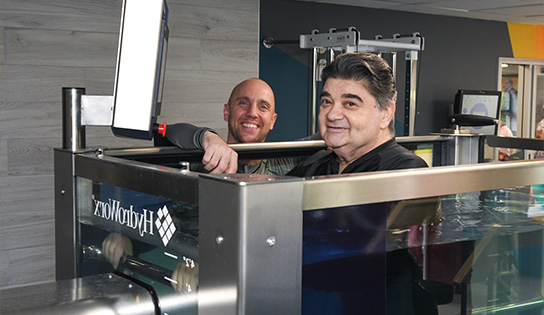Patients Age: 65
Admission Date: 12/30/16
Admitted From: Westchester Medical Center
Discharge Date: 3/29/17
Discharged To: Home
Length of Stay: 3 months
Reason for Stay: Recuperate from CVA
How did this patient hear about the Enclave? Westchester Medical Center
Details of Experience:
Ed was admitted to The Enclave at Rye Rehabilitation and Nursing Center on December 30, 2016 from Westchester Medical Center where he had spent three weeks following an intracerebral hemorrhage which caused a hemiparesis affecting his left side. He was nonverbal, required a g-tube for nutrition as his swallowing was affected, in addition to general deconditioning. Additionally, he was admitted with two unstageable pressure ulcers.
Within 24 hours of admission, Ed was greeted by his doctor, nurses and therapists who began to formulate his plan of treatment and therapy. He was assessed as requiring extensive assist of two for bed mobility, extensive assist of 1 for dressing, and a hoyer lift for transfers. His participation in therapy was limited due to his decline in cognitive function, in part due to vascular dementia. The goal was determined to improve quality of life so that Ed could return home and live with his family in the community.
The interdisciplinary team at The Enclave incorporated its Neurological Rehabilitation program into his physical, occupational, and speech therapies to coordinate Ed’s therapy and improve his overall well-being. Mike, his speech therapist, began working on improving swallowing, as well as cognition by focusing on verbal expression and auditory comprehension. As Ed’s cognition improved, his therapy sessions, which were focused on weight shifting, became more productive. Furthermore, for modalities, his therapists utilized electrical stimulation to enhance muscle contraction. In the beginning of February, these efforts began to bear fruit as Ed was started on a puree diet with honey thickened liquids, for one meal a day, his muscle tone improved from zero to two of five, and his bed mobility improved to a minimum assist of one. During this time, it was also determined that the pressure ulcers were a stage three and the nursing team, under the guidance of our wound care specialist, began treating the pressure sores.
Ed’s family was excited to see his improvement and, as his swallowing improved, began bringing in homemade food for him. The nursing staff noticed and educated the family to the potential risks of aspiration, which they accepted. At this time, Ed’s lower left extremity strength improved two grades, from 2+ to 3- and he was discharged from the hoyer lift to a maximum assist of two. The following weeks brought greater improvement in cognitive functioning, swallowing, and muscle tone. By mid-March Ed’s diet was upgraded to a mechanical soft with thin liquids and his pressure ulcers were completely healed. It was at this point that Cassandra, the social worker, began discharge planning with the family.
Upon discharge, Ed improved on multiple levels, which would allow him to return home and utilize family assistance. Bed mobility and transfers could be accomplished with moderate assist of one, with his sitting balance at side of the bed improving from G- to F+, greatly improving his core strength which is 3 out of 5. His diet now consisted of mechanical soft for three meals a day and his cognition improved to 8 from 5 upon admission. His upper left extremity strength improved to 4 of 5, allowing him to perform upper body activities of daily living independently while requiring only minimum assist of one for lower body dressing. The therapists provided the family with education so they can assist Ed with mobility and functioning at home. The staff takes great pride in having been able to restore quality of life for Ed and his family!


